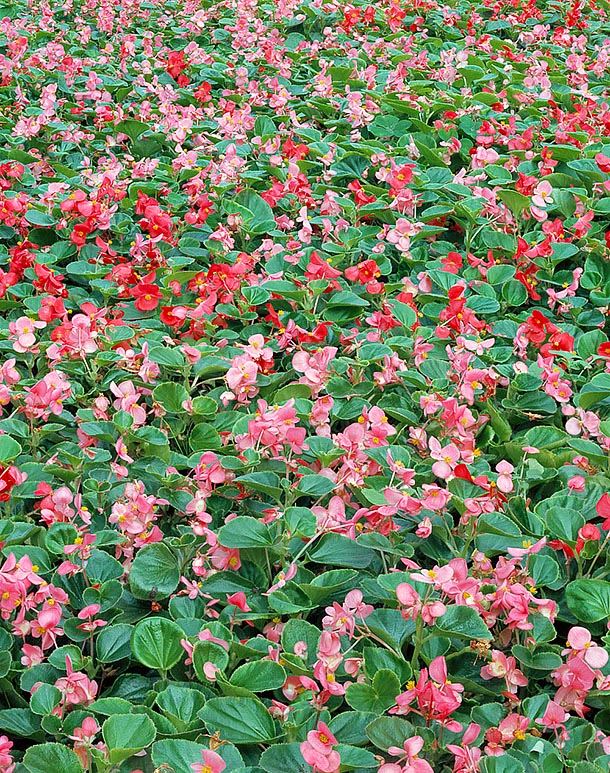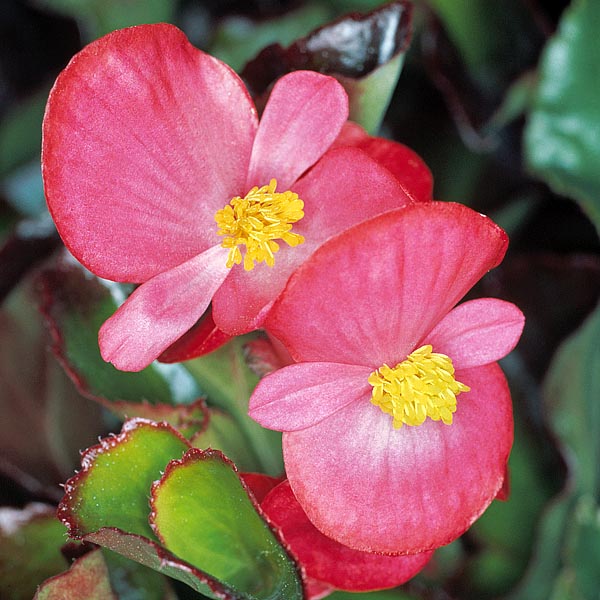Family : Begoniaceae

Text © Pietro Puccio

English translation by Mario Beltramini

Frequent borders and balcony plant, Begonia cucullata is native to South America © Giuseppe Mazza
The genus is honoured to the French naturalist and collector Michel Begon (1638-1710), who was governor of the French colonies in the Caribbean; the name of the species is the Latin word “cucullatus” = hooded, with reference to the form of the leaf which recalls the “cucullus”, typical Gallic headgear.
Common names: bedding begonia, club begonia, clubed begonia, semperflorens begonia, wax begonia (English); begonia, begonietta (Italian); bégonia, bégonia annuel, bégonia des jardins, bégonia d’intérieur (French); azeda-do-brejo, begônia-do-brejo, erva-de-sapo (Portuguese); begonia alta, begonia de cera, begonia vírgen, flor de nácar, semperflorens auténtica (Spanish); Begonie, Eisbegonie, Eisblume, Gottesauge, Beetbegonie (German).
Evergreen herbaceous with fascicled roots, 0,3-1 m tall, with green or reddish semi-succulent stems, it has slightly asymmetric leaves of glossy dark green colour on the upper side, and pale below, of ovate or elliptic shape, 8-14 cm long and 6-9 cm broad, bent and with undulated and incised margins, reddish at times.
The inflorescences are bisexual axillar cymes, with male flowers having four white or pink tepals, those of the outer couple are almost circular, with a diameter of 8-15 mm, those of the inner one, obovate, about 10 mm long and
6 mm broad.
Female flowers with 4-5 tepals of the same colour as the male ones, elliptic or obovate, 4-14 mm long and 2-8 mm broad. The fruits are tri-winged capsules, 2-3 cm long and containing several very small seeds. It reproduces by seed, to be distributed superficially and to be kept at a temperature of 22-24 °C, and by stem and leaf cutting.

Colours going from white to pink, red in the various shades, and almost continuous flowering. Few know that the leaves are edible and can be consumed cooked or raw © Giuseppe Mazza
Even if it prefers a slightly shaded position, it adapts also to the shade and to the full sun, provided the substratum is constantly kept humid during the vegetative period.
In the tropics and the sub-tropics, where it often escapes from the cultivation, naturalizing and becoming a pest, it can be cultivated in full earth on a permanent way, elsewhere it is usually cultivated as annual, seen its facility of reproduction, blossoming from the spring to the first frosts.
When in pot, mainly utilized for balconies and terraces decoration, it needs porous substrata, draining, acidic (pH from 5,5 to 6,5) and rich of organic substance, and regular watering in summer; if wanted, it can winter in enclosed spaces in luminous position, with reduced watering, being rather sensitive to water stagnations, and temperatures are not to go under 12-14 °C.
The leaves are edible and can be consumed either raw or cooked.
Synonyms: Begonia nervosa Kunth in F.W.H.von Humboldt (1825); Begonia dispar Rchb. (1829); Begonia semperflorens Link & Otto (1829); Begonia setaria Graham (1829); Begonia cucullifolia Hassk. (1858); Begonia semperflorens f. flavescens C.DC. (1903); Begonia paludicola C.DC. (1914).
→ To appreciate the biodiversity within the BEGONIACEAE family please click here.
